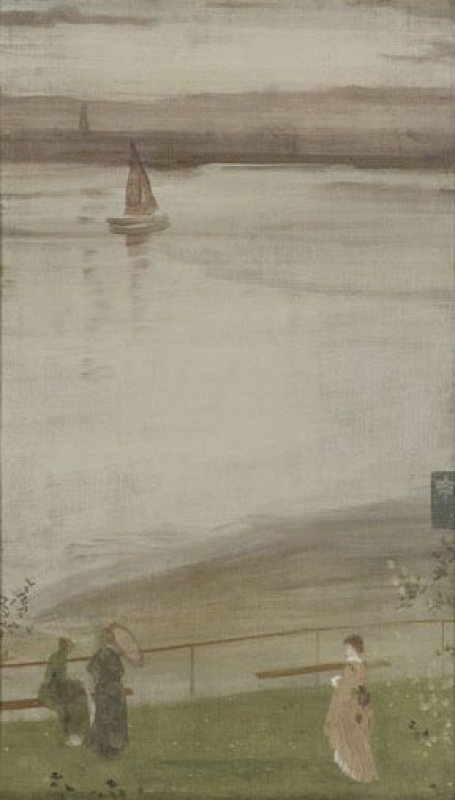Provenance
- By 1886: owned by Charles Benjamin Bright McLaren (1st Lord Aberconway) (1850-1934) , later Lord Aberconway, until at least 1911.
- 1950: bought from Paul Mellon (1907-1999) , Pittsburgh, by Scott & Fowles, New York dealers;
- 1950: sold by them to the Macbeth Gallery, New York;
- 1950: sold by the Macbeth Gallery to Carolyn Glendenin Foulke (née Ryan) (1910-1987) , New York and (in the 1960s) Florida;
- 1987: sold at auction, Sotheby's, New York, 28 May 1987 (lot 3), bought by James Maroney (n/a) , New York art dealer;
- 1995: acquired by the musées nationaux de France;
- 1995: Musée d'Orsay, Paris.
It is not known what happened to this painting at the time of Whistler's bankruptcy. It may have been bought about that time by Charles Benjamin Bright McLaren. It was listed by Whistler around 1886 or 1887 as 'Green & Pink - McLaren'. 1 McLaren still owned it in 1911 when it was reproduced by the Pennells. 2 It may have been sold by him or by his son or grandson, the second and third Baron Aberconways.
According to Robert G. McIntyre of the William Macbeth Galleries it was bought from Paul Mellon, by Scott & Fowles, who sold it to Macbeth's in 1950, and they sold it to Mrs C. R. Foulke in the same year. 3
It was acquired by the musées nationaux de France with the support of the concours du Fonds National du Patrimoine, and the participation of Philippe Meyer, in 1995. 4
Exhibitions
- 1871: 5th Winter Exhibition of Cabinet Pictures in Oil, under the Management of the Committee of the Dudley Gallery, London, 1871 (cat. no. 225) as 'Variations in Violet and Green'.
- 1905: Memorial Exhibition of the Works of the late James McNeill Whistler, First President of The International Society of Sculptors, Painters and Gravers, New Gallery, Regent Street, London, 1905 (cat. no. 81).
Edward John Poynter (1836-1919) told Whistler that it had been 'properly placed' at the Dudley Gallery in 1871, adding, 'If you think my opinion worth anything, perhaps you will allow me to say how very much I admire both the paintings.' 5 Walter Greaves (1846-1930) and his brother Henry Greaves (1843-1904) were asked by Whistler to check his exhibits at the Dudley Gallery, and they reported favourably. Whistler replied, 'I am very glad you and Harry have been to the Dudley - and that the two "harmonies" look swell among the crowd.' 6 A review of the exhibition at the Dudley Gallery appeared in The Times in 1871. Despite an apparently disparaging description of the painting as 'some slightly indicated female personages on a shadowy balcony. The only way to explain the perspective ... is to suppose [the picture was] painted from a high window' - the review was an important assessment of Whistler's aims and achievements:
'They are illustrative of the theory, not confined to this painter, but most conspicuously and ably worked out by him, that painting is so closely akin to music that the colours of the one may and should be used, like the ordered sounds of the other, as means and influences of vague emotion; that painting should not aim at expressing dramatic emotions, depicting incidents of history, or recording facts of nature, but should be content with moulding our moods and stirring our imaginations, by subtle combinations of colour through which all that painting has to say to us can be said, and beyond which painting has no valuable or true speech whatever. … The only way to explain the perspective of the pictures is to suppose them painted from a high window. The colour, consistently with the theory of the painter, is carried out into the frames by means of delicate diaperings and ripplings of faint greens and moony blues on their gold, and the Japanese influence in which the painter delights is carried even to the introduction of the coloured cartouche, which on the Japanese screen bears the address of the painter or seller. Mr. Whistler has introduced his own monogram or symbol in this way, carefully attuning the colour of the cartouche to the dominant harmony of his picture. With all the apparent slightness of the work, the management of colour all through is governed by the subtlest calculation, and the gradation and juxtaposition of delicate tones appeal to the finest chromatic susceptibles.' 7
However, reviews varied greatly: The Examiner on 28 October praised Nocturne: Blue and Silver - Chelsea [YMSM 103] and Variations in Violet and Green as 'two experiments in the combination of colour … wonderful things', but on 10 November 1871 the Morning Advertiser described them as 'eccentric productions' and mere 'smudges'.
Notes:
1: List, [1886/1887], formerly dated [4/11 January 1892], GUW #06795.
2: Pennell 1911 A [more] , f.p. 113.
3: McIntyre to A. McL. Young, 25 March 1960; in a letter from McIntyre to J. W. Revillon, 8 March 1950, he suggested that the chalk inscription 'From Brown' on the verso might mean it had passed through the hands of Brown & Phillips in London. Source: GUL WPP files.
4: Comité du 9 March 1995, conseil du 15 March 1995, arrêté du 21 March 1995.
5: 10 October 1871, GUW #05011.
6: Whistler to W. Greaves, [October/November 1871], GUW #11469; quoted from [14 November/December 1871], GUW #11496.
7: Anon., 'Dudley Gallery. - Cabinet Pictures in Oil', The Times, London, 14 November 1871, p. 4.
Last updated: 31st December 2020 by Margaret





